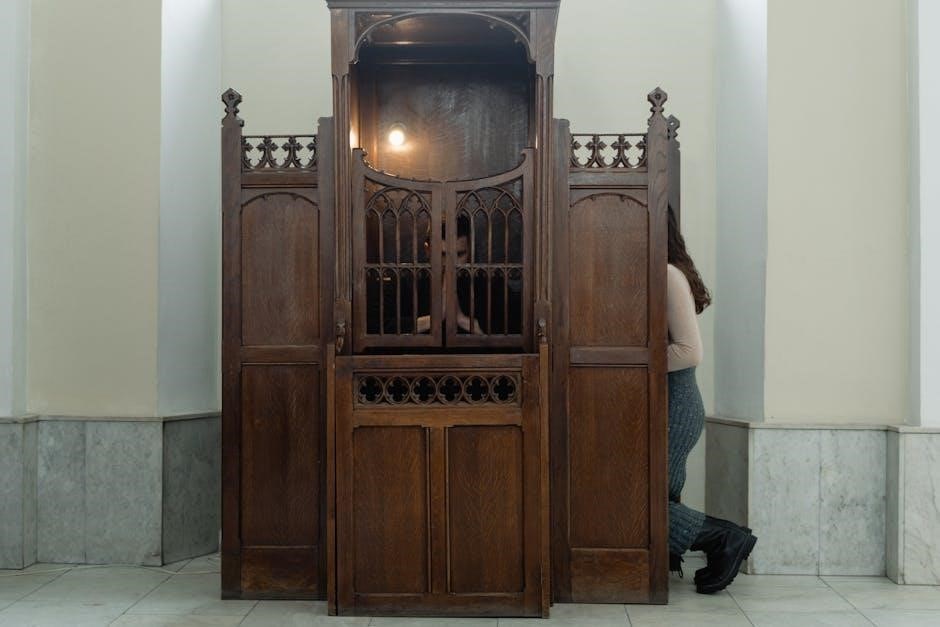How to Go to Confession: A Catholic Guide
Confession, or the Sacrament of Reconciliation, offers healing and forgiveness. Prepare through prayer, reflection, and examining your conscience. Seek God’s grace for a good confession. Embrace repentance and resolve to avoid future sins. Resources like guides and examinations of conscience are available to help you prepare well.

Understanding the Sacrament of Reconciliation
The Sacrament of Reconciliation, also known as Confession or Penance, is a profound encounter with Jesus Christ. Through it, we receive forgiveness for our sins and experience God’s boundless mercy. This sacrament, rooted in the teachings of the Church, offers a pathway to spiritual healing and renewal. It’s a powerful means of grace, restoring our relationship with God and the Church community.
Jesus Christ, after his resurrection, breathed the Holy Spirit on his Apostles, granting them the authority to forgive sins in his name. This divine power continues through priests today, making them instruments of God’s forgiveness. When we confess our sins to a priest, we are confessing to Christ himself, who acts through the priest to absolve us.
Understanding the sacrament involves recognizing our need for God’s grace and mercy. It requires humility and a sincere desire to turn away from sin. Confession isn’t merely a checklist of wrongdoings; it’s a heartfelt expression of sorrow and a commitment to amend our lives. It’s an opportunity to receive guidance and encouragement from the priest, who offers counsel to help us grow in holiness. By understanding the depth and significance of this sacrament, we can approach it with reverence and openness, allowing God’s love to transform us.
Preparing for Confession: Examination of Conscience
Preparing for Confession begins with a thorough examination of conscience, a reflective process of prayerfully reviewing our thoughts, words, and actions since our last confession. This involves honestly assessing how we have lived in accordance with God’s commandments and the teachings of the Church.
To conduct a fruitful examination, find a quiet space and ask the Holy Spirit for guidance. Reflect on various aspects of your life: your relationship with God, your family, your neighbors, and yourself. Consider the Ten Commandments, the Beatitudes, and the precepts of the Church as frameworks for your reflection. Ask yourself if you have loved God above all else, respected the name of the Lord, kept holy the Sabbath, honored your parents, avoided harming others, and been truthful in your words.

Be specific and honest in identifying your sins, both mortal and venial. Mortal sins are grave offenses committed with full knowledge and deliberate consent, while venial sins are lesser offenses that weaken our relationship with God. It’s helpful to consider the frequency and circumstances of your sins to gain a clearer understanding. Avoid dwelling on feelings of guilt or shame; instead, focus on acknowledging your sins and seeking God’s forgiveness. Remember that the purpose of the examination is not to condemn yourself, but to prepare your heart for the healing power of Confession.
Contrition: Sorrow and Resolution
Contrition, a vital component of a good confession, involves genuine sorrow for our sins and a firm resolution to avoid them in the future. It’s not merely feeling bad about getting caught, but a heartfelt regret for offending God, who loves us unconditionally. This sorrow stems from recognizing the harm our sins inflict on ourselves, others, and our relationship with God.
Perfect contrition arises from love of God, prompting us to be sorry for having offended Him. Imperfect contrition, on the other hand, arises from other motives, such as fear of punishment or the ugliness of sin. While perfect contrition remits sin, it is rare; thus, imperfect contrition suffices when coupled with the Sacrament of Reconciliation.
Equally important is the resolution to amend our lives. This means making a firm commitment to avoid the occasions of sin and to take concrete steps to change our behavior. This resolution should be specific and practical, focusing on addressing the root causes of our sins. It is a promise made to God, with His grace, to strive for holiness and to live a life more pleasing to Him. Without genuine sorrow and a firm resolution, the sacrament lacks its intended effect.

Entering the Confessional
Approaching the confessional can be a moment filled with anticipation and perhaps a bit of nervousness. Remember that this is a sacred space, a place of healing and reconciliation with God. When entering, you usually have the option of remaining anonymous behind a screen or speaking face-to-face with the priest; choose whichever makes you feel more comfortable and facilitates an honest confession.
If there’s a light indicating the confessional is in use, wait patiently and respectfully. Once it’s your turn, step inside and either kneel behind the screen or sit in the chair opposite the priest, depending on your chosen method. Make the Sign of the Cross, saying, “In the name of the Father, and of the Son, and of the Holy Spirit. Amen.” This simple act invokes God’s presence and sets the tone for the encounter.
Following this, you’ll typically greet the priest with the words, “Bless me, Father, for I have sinned.” Then state how long it has been since your last confession. This provides context for the priest and helps him understand your spiritual journey. Remember, the priest is there to guide and support you, so approach this moment with humility and trust, ready to receive God’s grace.
Greeting the Priest
The initial greeting sets the stage for the Sacrament of Reconciliation, establishing a connection between you and the priest, who acts as Christ’s representative. After entering the confessional, whether choosing the anonymous screen or face-to-face setting, begin with the Sign of the Cross. This simple yet powerful gesture invokes the Holy Trinity – Father, Son, and Holy Spirit – acknowledging God’s presence and inviting His grace into the encounter.
Following the Sign of the Cross, the traditional and universally recognized greeting is: “Bless me, Father, for I have sinned.” This phrase immediately conveys your purpose and acknowledges your need for God’s mercy. It’s a humble admission of your imperfections and a request for the priest’s blessing as you embark on this journey of repentance.
Next, state the time elapsed since your last confession. For example, “It has been [number] weeks/months/years since my last confession.” This provides the priest with context and helps him understand your spiritual journey. Be honest and accurate in your estimation. This information allows the priest to better guide you and offer appropriate counsel, fostering a more meaningful and effective experience of reconciliation.
Confessing Your Sins
After the initial greeting, the heart of the Sacrament of Reconciliation unfolds: confessing your sins. This involves honestly and humbly acknowledging your transgressions to the priest. Remember, the priest is there to help you receive God’s forgiveness, acting as a compassionate guide on your path to spiritual healing. Be forthright and specific, detailing the sins you have committed since your last confession. It is important to confess all mortal sins, specifying the number of times each was committed, if possible.
For venial sins, while not obligatory to confess, doing so can be beneficial for spiritual growth and receiving grace. If unsure whether a sin is mortal or venial, seek guidance from the priest.
Describe each sin clearly, avoiding unnecessary details or justifications. Focus on the act itself and your role in it. It is vital to avoid mentioning other people’s involvement or casting blame. The focus is on your own accountability and seeking forgiveness for your actions. If you are unsure how to articulate a sin, ask the priest for assistance. He is there to guide you and help you express yourself clearly and honestly, fostering a deeper understanding of your actions and their impact.
Seeking Guidance from the Priest
Confession isn’t merely a recitation of sins; it’s an opportunity to seek spiritual guidance. The priest, acting as a representative of Christ, is there to offer counsel and support. Don’t hesitate to ask questions about your faith, moral dilemmas, or struggles with specific sins. If you’re unsure whether something constitutes a sin, or how to overcome a particular temptation, the priest can provide valuable insight and direction.
He can help you understand the gravity of your actions, and offer practical advice for amending your life. The priest’s role is not to judge, but to guide you towards a closer relationship with God. Embrace this opportunity to discuss your spiritual concerns, seek clarity on Church teachings, and receive personalized guidance tailored to your specific needs. Remember, he has heard countless confessions and can offer perspective and wisdom.
He might suggest specific prayers, practices, or changes in behavior to help you grow spiritually and avoid future sins. This dialogue is an integral part of the healing process, allowing you to gain a deeper understanding of yourself, your relationship with God, and the path to virtuous living. Be open and receptive to the priest’s advice, knowing that his guidance is rooted in the teachings of the Church and a genuine desire to help you on your spiritual journey.
Receiving Absolution
Absolution is the culmination of the Sacrament of Reconciliation, the moment when God, through the priest, forgives your sins. After you have confessed your sins and received guidance, the priest will extend his hands over you, or raise his hand, and pronounce the words of absolution. This prayer signifies that your sins are forgiven in the name of the Father, the Son, and the Holy Spirit.
As the priest says these words, make the Sign of the Cross, signifying your acceptance of God’s mercy. This is a powerful moment of grace, a tangible sign of God’s love and forgiveness. It signifies a fresh start, a cleansing of your soul, and a renewed opportunity to live a life pleasing to God. Embrace the peace and joy that comes with knowing you are forgiven.
Understand that absolution is not merely a symbolic gesture; it is a real and efficacious sacrament. Through the priest’s ministry, God truly forgives your sins, restoring you to a state of grace. Believe in the power of this sacrament and allow yourself to be transformed by God’s mercy. Remember that God’s forgiveness is always available to those who sincerely repent and seek reconciliation. Let the experience of receiving absolution strengthen your resolve to avoid sin and live a life dedicated to God’s will.
Performing the Assigned Penance

Following absolution, the priest will assign you a penance. This is an act of reparation, a way to express your sorrow for your sins and to begin the process of healing and spiritual growth. The penance is usually a prayer, a devotional act, or a work of charity. It is a tangible way to demonstrate your commitment to amending your life and avoiding sin in the future.
It is important to perform the assigned penance as soon as possible after confession. This shows your sincerity and your desire to make amends for your actions. The penance is not meant to be a punishment, but rather an opportunity to draw closer to God and to grow in virtue. Embrace the penance with a spirit of humility and gratitude, recognizing that it is a gift from God to help you on your journey of faith.
If you are unsure about how to perform the penance, or if you have any questions about it, do not hesitate to ask the priest for clarification. He is there to guide you and to help you understand the meaning and purpose of the penance. By faithfully performing the assigned penance, you are actively participating in the healing process and strengthening your relationship with God. It is a concrete step towards living a more virtuous and fulfilling life, free from the burden of sin.
Thanksgiving After Confession
After receiving absolution and performing your penance, it is essential to offer thanksgiving to God for His boundless mercy and forgiveness. This act of gratitude is a vital part of the reconciliation process, allowing you to fully embrace the grace you have received and to deepen your relationship with the Lord. Find a quiet space to reflect on the sacrament and the profound gift of forgiveness.
Express your heartfelt thanks to God for His unwavering love, which extends even to those who have strayed from His path. Acknowledge the power of His grace to heal and restore your soul. Consider the weight of the sins that have been lifted from you and the freedom that comes with a clean conscience. Recognize the opportunity you have been given to begin anew, to live a life more aligned with God’s will.
Offer a prayer of thanksgiving, expressing your gratitude for the priest who served as Christ’s instrument in administering the sacrament. Thank God for the Church, which provides this means of grace and reconciliation. Resolve to live a life worthy of the forgiveness you have received, striving to avoid sin and to grow in holiness. Let the joy and peace of reconciliation fill your heart, empowering you to share God’s love with others. Carry this spirit of gratitude with you, allowing it to shape your thoughts, words, and actions in the days and weeks to come.
